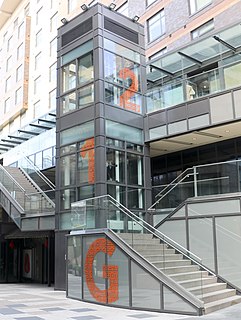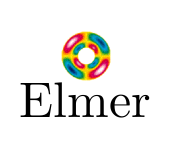Related Research Articles

In computer science, model checking or property checking is a method for checking whether a finite-state model of a system meets a given specification. This is typically associated with hardware or software systems, where the specification contains liveness requirements as well as safety requirements.
NASTRAN is a finite element analysis (FEA) program that was originally developed for NASA in the late 1960s under United States government funding for the aerospace industry. The MacNeal-Schwendler Corporation (MSC) was one of the principal and original developers of the publicly available NASTRAN code. NASTRAN source code is integrated in a number of different software packages, which are distributed by a range of companies.
The boundary element method (BEM) is a numerical computational method of solving linear partial differential equations which have been formulated as integral equations. including fluid mechanics, acoustics, electromagnetics, fracture mechanics, and contact mechanics.
Finite-difference time-domain or Yee's method is a numerical analysis technique used for modeling computational electrodynamics. Since it is a time-domain method, FDTD solutions can cover a wide frequency range with a single simulation run, and treat nonlinear material properties in a natural way.

An ultrasonic motor is a type of electric motor powered by the ultrasonic vibration of a component, the stator, placed against another component, the rotor or slider depending on the scheme of operation. Ultrasonic motors differ from piezoelectric actuators in several ways, though both typically use some form of piezoelectric material, most often lead zirconate titanate and occasionally lithium niobate or other single-crystal materials. The most obvious difference is the use of resonance to amplify the vibration of the stator in contact with the rotor in ultrasonic motors. Ultrasonic motors also offer arbitrarily large

Elmer is computational tool for multi-physics problems. It has been developed by CSC in collaboration with Finnish universities, research laboratories and industry. Elmer FEM solver is free and open-source software, subject to the requirements of the GNU General Public License (GPL), version 2 or any later.
Computational electromagnetics (CEM), computational electrodynamics or electromagnetic modeling is the process of modeling the interaction of electromagnetic fields with physical objects and the environment.
A thin-film bulk acoustic resonator is a device consisting of a piezoelectric material manufactured by thin film methods sandwiched between two electrodes and acoustically isolated from the surrounding medium. FBAR devices using piezoelectric films with thicknesses ranging from several micrometres down to tenth of micrometres resonate in the frequency range of roughly 100 MHz to 20 GHz, . Any material like lead zirconate titanate (PZT) or barium strontium titanate (BST) from the list of piezoelectric materials could act as an active material in an FBAR resonator. However aluminium nitride (AlN) and zinc oxide are two most studied piezoelectric materials for FBAR realisations. As two compound material and compatibility with the silicon integrated circuit technology AlN has become the most widely used in commercial volume manufacturing of FBAR resonator based products.
Dassault Systèmes Simulia Corp. is an computer-aided engineering (CAE) vendor. Formerly known as Abaqus Inc. and previously Hibbitt, Karlsson & Sorensen, Inc., (HKS), the company was founded in 1978 by David Hibbitt, Bengt Karlsson and Paul Sorensen, and has its headquarters in Providence, Rhode Island.
The finite-difference frequency-domain (FDFD) method is a numerical solution method for problems usually in electromagnetism and sometimes in acoustics, based on finite-difference approximations of the derivative operators in the differential equation being solved.
Abaqus FEA is a software suite for finite element analysis and computer-aided engineering, originally released in 1978. The name and logo of this software are based on the abacus calculation tool. The Abaqus product suite consists of five core software products:
- Abaqus/CAE, or "Complete Abaqus Environment". It is a software application used for both the modeling and analysis of mechanical components and assemblies (pre-processing) and visualizing the finite element analysis result. A subset of Abaqus/CAE including only the post-processing module can be launched independently in the Abaqus/Viewer product.
- Abaqus/Standard, a general-purpose Finite-Element analyzer that employs implicit integration scheme (traditional).
- Abaqus/Explicit, a special-purpose Finite-Element analyzer that employs explicit integration scheme to solve highly nonlinear systems with many complex contacts under transient loads.
- Abaqus/CFD, a Computational Fluid Dynamics software application which provides advanced computational fluid dynamics capabilities with extensive support for preprocessing and postprocessing provided in Abaqus/CAE.
- Abaqus/Electromagnetic, a Computational electromagnetics software application which solves advanced computational electromagnetic problems.

The finite element method (FEM) is the most widely used method for solving problems of engineering and mathematical models. Typical problem areas of interest include the traditional fields of structural analysis, heat transfer, fluid flow, mass transport, and electromagnetic potential. The FEM is a particular numerical method for solving partial differential equations in two or three space variables. To solve a problem, the FEM subdivides a large system into smaller, simpler parts that are called finite elements. This is achieved by a particular space discretisation in the space dimensions, which is implemented by the construction of a mesh of the object: the numerical domain for the solution, which has a finite number of points. The finite element method formulation of a boundary value problem finally results in a system of algebraic equations. The method approximates the unknown function over the domain. The simple equations that model these finite elements are then assembled into a larger system of equations that models the entire problem. The FEM then uses variational methods from the calculus of variations to approximate a solution by minimizing an associated error function.
In numerical analysis, coarse problem is an auxiliary system of equations used in an iterative method for the solution of a given larger system of equations. A coarse problem is basically a version of the same problem at a lower resolution, retaining its essential characteristics, but with fewer variables. The purpose of the coarse problem is to propagate information throughout the whole problem globally.
ADINA is a commercial engineering simulation software program that is developed and distributed worldwide by ADINA R & D, Inc. The company was founded in 1986 by Dr. Klaus-Jürgen Bathe, and is headquartered in Watertown, Massachusetts, United States.

Flexcom is a finite element package used in the offshore oil and gas and marine renewable energy industries. An educational version is also available for universities.
Nektar++ is a spectral/hp element framework designed to support the construction of efficient high-performance scalable solvers for a wide range of partial differential equations (PDE). The code is released as open-source under the MIT license. Although primarily driven by application-based research, it has been designed as a platform to support the development of novel numerical techniques in the area of high-order finite element methods.
Synthetic Aperture Ultrasound (SAU) Imaging is an advanced form of imaging technology used to form high-resolution images in biomedical ultrasound systems. Ultrasound Imaging has become an important and popular medical imaging method, as it is safer and more economical than computer tomography (CT) and magnetic resonance imaging (MRI). Compared with the conventional ultrasound image formation where one transducer or linear array is used, SAU imaging has achieved higher lateral resolution and deeper penetration, which will enable a more accurate diagnosis in medical applications, with no obvious loss in frame rate and without a large burden in computational complexities.
The infinite element method is a numerical method for solving problems of engineering and mathematical physics. It is a modification of finite element method. The method divides the domain concerned into infinitely many sections. In the first instance this results in an infinite set of equations, which is then reduced to a finite set. The method is commonly used to solve acoustic problems.
Kathryn Radabaugh Nightingale is an American biomedical engineer in the field of medical ultrasound. She is the James L. and Elizabeth M. Vincent Professor of Biomedical Engineering at Duke University in Durham, North Carolina. Nightingale is also a Member of the Duke Cancer Institute and Bass Fellow in the Duke University Pratt School of Engineering.
References
- ↑ Wojcik, GL; Vaughan, DK; Abboud, N; Mould, JJr (1993). Electromechanical Modeling Using Explicit Time-Domain Finite Elements (PDF). IEEE Ultrasonics Symposium. pp. 1107–1112.
- ↑ Abboud, N; Wojcik, GL; Vaughan, DK; Mould, J; Powell, DJ; Nikodym, L (1998). Finite Element Modeling for Ultrasonic Transducers (PDF). Medical Imaging 1998. pp. 19–42.
- ↑ Wojcik, GL; Mould, JJr; Lizzi, F; Abboud, N; Ostomogilsky, M; Vaughan, D (1995). Nonlinear Modeling of Therapeutic Ultrasound (PDF). IEEE Ultrasonics Symposium. pp. 1617–1622.
- ↑ Wojcik, GL; Vaughan, DK; Murray, V; Mould, JJr (1994). Time-Domain Modeling of Composite Arrays for Underwater Imaging (PDF). IEEE Ultrasonics Symposium. pp. 1027–1032.
- ↑ Harvey, G; Tweedie, A; Carpentier, C; Reynolds, P (2011). Finite element analysis of ultrasonic phased array inspections on anisotropic welds (PDF). American Institute of Physics. pp. 827–834.
- 1 2 "PZflex Packages". pzflex.com. Weidlinger Associates Inc. Retrieved 25 November 2015.